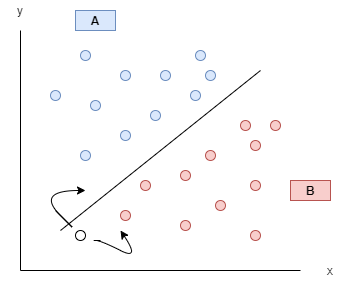Concept 4: Machine Learning Process
Machine Learning Implementation Process
:dart: Learning Objectives
By the end of this lesson, you will be able to:
- Identify the three key processes in machine learning implementation
- Understand how to prepare data for machine learning
- Learn how to train and test machine learning models
- Apply best practices for building AI systems
:information_source: What is Machine Learning Implementation? Machine learning implementation is the step-by-step process we follow to teach computers how to learn from data and make predictions. Think of it like teaching a friend to recognize patterns - we show them examples, help them practice, and then test their knowledge!
There are 3 key processes we follow when implementing machine learning to develop AI systems.
Each key process has several important steps:
-
Data Preparation :bar_chart:
- Acquire a Dataset - Finding the right data to teach our AI
- Prepare the Data - Cleaning and organizing data for learning
-
Model Training :emoji:
- Choosing a model - Selecting the right learning method
- Training the model - Teaching the AI to recognize patterns
-
Model Testing :white_check_mark:
- Evaluating how well our AI learned
:memo: Key Components for Success To make machine learning work, you need two essential things:
- A dataset - A collection of examples for the AI to learn from (bigger is usually better!)
- A model - A special file that contains all the patterns the AI learned
Think of it like learning to ride a bike: the dataset is like all your practice sessions, and the model is your brain remembering how to balance and pedal!
:bar_chart: Data Preparation
:information_source: What is Data Preparation? Data Preparation is getting your data ready for machine learning - just like preparing ingredients before cooking! We find good data and organize it so our AI can learn effectively.
:mag: Acquire a Dataset
To build a great AI model, we need to find the best dataset to teach it with.
Here are the qualities that make a dataset great for learning:
- Large quantity of data :chart_with_upwards_trend:
- We recommend using datasets with more than 1,000 examples
- Why? More examples give our AI more chances to learn useful patterns
- Let's look at an example with two datasets for teaching an AI to recognize apples:
Dataset 1
| Shape | Taste | Colour | Apple? |
|---|---|---|---|
| Round | Sweet | Red | Yes |
| Round | Sour | Red | Yes |
Dataset 2
| Shape | Taste | Colour | Apple? |
|---|---|---|---|
| Round | Sweet | Red | Yes |
| Round | Sour | Red | Yes |
| Round | Sour | Green | Yes |
-
If we only use Dataset 1, our AI won't learn that apples can be green too!
-
Remember: There's a sweet spot for data. After a certain point, adding more data won't make the AI much smarter.
-
Large number of features :mag:
-
Features are characteristics that help identify objects (like color, shape, size)
-
More features help the AI spot unique patterns better
-
Look at this apple and orange comparison:

- Using only shape? The AI gets confused - both fruits are round!
- Add color as a feature? Now the AI can tell them apart easily!
-
Be careful: Too many features can actually confuse the AI and slow it down
-
-
Minimal amount of errors :warning:
-
Wrong data teaches wrong patterns - like teaching with incorrect answers!
-
Example: What happens if we use these wrong pictures to teach about apples?

-
The AI learns that apples are blue or black (wrong!)
-
When it sees a real red apple, it won't recognize it:

-
-
:bulb: Where to Find Datasets A great place to find datasets is Kaggle - it's like a library for AI data!
:emoji: Prepare the Data
Before teaching our AI, we need to make sure the data is clean and ready.
The first step is to explore the dataset - like checking your ingredients before cooking!
What to look for:
- Structure - How many features (columns) does your data have?
- Type - Is it text, images, or numbers?
- Size - How many examples do you have?
Next, we perform data cleaning - removing the mess from our data:
- Remove unnecessary or duplicate data (no repeats!)
- Fill in or remove missing values (no blank spots!)
- Convert data types (like changing "5" text to the number 5)
After cleaning, we do data preprocessing to make the data AI-friendly:
- Why? To convert data into a format our AI can understand
- Examples:
- Convert words to numbers (AI prefers numbers!)
- Adjust number ranges to be consistent
Finally, we split the dataset into two parts:
- Training dataset (about 2/3) - For teaching the AI
- Testing dataset (about 1/3) - For checking if the AI learned correctly
:memo: Think of it This Way It's like studying for a test - you practice with some problems (training), then test yourself with new problems you haven't seen before (testing)!
:emoji: Model Training
:information_source: What is Model Training? Model Training is teaching our AI to recognize patterns by showing it lots of examples. It's like teaching a puppy new tricks - practice makes perfect!
A Machine Learning (ML) model is like a smart file that learns to recognize patterns from the examples we show it.
To build these smart models, we follow 2 important steps:
- Choosing a model - Picking the right learning method
- Training the model - Teaching it with our data
:dart: Choosing a Model
We need to choose a model that matches what we want our AI to do.
Different models solve different problems:
-
Regression model :chart_with_upwards_trend: - For predicting numbers
- Example: Predicting tomorrow's temperature
- Example: Estimating house prices
-
Classification model :package: - For sorting things into categories
- Example: Is this email spam or not? (Text Recognition)
- Example: What animal is in this picture? (Image Recognition)

:muscle: Training the Model
After choosing our model, it's time to train it!
During training:
- We feed our prepared data to the model
- The model looks for patterns in the data
- It learns to make predictions based on those patterns
The more examples we show it, the better it gets at recognizing patterns!
:white_check_mark: Model Testing
:information_source: What is Model Testing? Model Testing is checking how well our AI learned by giving it a quiz with new examples it hasn't seen before. It's like taking a final exam after studying!
After training our model, we need to answer these important questions:
- How well did our AI learn? :emoji:
- Should we train it more? :books:
We measure success using model accuracy - how often the AI gets the right answer.
Real-world examples:
- Can a pet recognition app correctly tell cats from dogs?
- How accurately does Siri understand your questions?
:bulb: Testing Best Practice Always test with new data the AI hasn't seen during training. This testing data shows us how well the AI will work in real life!
If accuracy is low, we can:
- Find better training data :bar_chart:
- Try a different learning method :emoji:
The tools we use to measure accuracy are called metrics - they're like report cards for AI!
:memo: Summary
Let's recap the three key processes in machine learning:
- Data Preparation :bar_chart: - Finding and organizing good data for learning
- Model Training :emoji: - Teaching the AI to recognize patterns
- Model Testing :white_check_mark: - Checking how well the AI learned
Remember: Building AI is like teaching - you need good examples, patient practice, and regular testing!
:movie_camera: Video Learning
:bulb: Practice with AI
Understanding the Machine Learning Workflow
Try these prompts to explore machine learning concepts:
Starter Prompts:
- "What are the main steps in a typical machine learning project workflow?"
- "How do I evaluate and validate a machine learning model?"
Working with Data Preparation
Practice data preparation with these prompts:
Coding Prompts:
- "How do I handle missing values in a dataset using scikit-learn?"
- "Write Python code to split a dataset into training and testing sets."
:rocket: Your Turn!
Now that you understand the machine learning process:
- Think About It: What kind of AI would you like to build? What data would you need?
- Explore: Visit Kaggle and find a dataset that interests you
- Practice: Try explaining the three ML processes to a friend using your own examples
- Challenge: Can you think of why we need separate training and testing data? (Hint: It's like studying with a practice test vs. the real test!)

